-
Welcome to rpgcodex.net, a site dedicated to discussing computer based role-playing games in a free and open fashion. We're less strict than other forums, but please refer to the rules.
"This message is awaiting moderator approval": All new users must pass through our moderation queue before they will be able to post normally. Until your account has "passed" your posts will only be visible to yourself (and moderators) until they are approved. Give us a week to get around to approving / deleting / ignoring your mundane opinion on crap before hassling us about it. Once you have passed the moderation period (think of it as a test), you will be able to post normally, just like all the other retards.

- Joined
- Jun 28, 2017
- Messages
- 33,584
Reminder to not buy the DLC and instead just unlock them with CreamAPI.
tabacila
Augur
- Joined
- Nov 2, 2011
- Messages
- 326
Release in February. Much closer than I expected.
Blog post about new and old stuff:
Low res WH3 main campaign map image

Seems like the map is wrapped around the north pole and the Chaos Realms will be physical places on the map.
Blog post about new and old stuff:
TOTAL WAR: WARHAMMER III FAQ
TOTAL WAR: WARHAMMER III
Ella McConnell
November 4 2021
Welcome to the FAQ for Total War: WARHAMMER III – here you can find links to a lot of our other content about the game, as well as all the vital stats of the game itself.
中文版请在我们的Bilibili专栏查看
PLATFORMS & STOREFRONTS
WHAT IS THE TOTAL WAR: WARHAMMER III RELEASE DATE?
Total War: WARHAMMER III will release on February 17, 2022. Pre-order now.
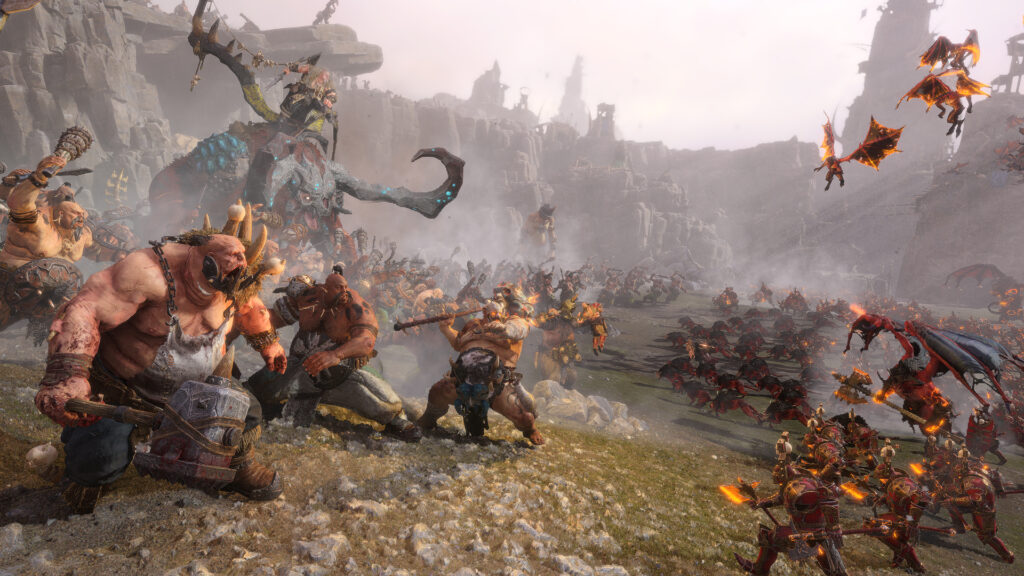
WHICH PLATFORMS WILL TOTAL WAR: WARHAMMER III BE AVAILABLE ON?
Total War: WARHAMMER III will be available on PC and will also be available as close to launch day as possible on macOS and Linux thanks to our friends at Feral Interactive – we’ll be confirming exactly when closer to release day.
WHICH STORES WILL TOTAL WAR: WARHAMMER III BE AVAILABLE THROUGH?
You can pick up your copy of Total War: WARHAMMER III on Steam, the Epic Games Store, and the Microsoft Store. You can also purchase your copy directly from Creative Assembly here – the only difference is that more of the price you pay will go directly to the studio.
In addition, Total War: WARHAMMER III will be available as part of Game Pass for PC. See below for more details.
Other digital storefronts are also available – please check SEGA’s list of approved partners here.
Physical copies of Total War: WARHAMMER III will also be available in most territories – please check with your preferred local game stockist.
IS THE GAME PASS FOR PC VERSION ANY DIFFERENT?
No, it is the full version of the game. If you own WARHAMMER III through Game Pass for PC, you will also be able to purchase future DLC for it through the Microsoft Store, as well as access Free-LC as it becomes available. For more information on Game Pass for PC, click here.
ARE THERE SPECIAL EDITIONS OF TOTAL WAR: WARHAMMER III?
We have two physical special editions for WARHAMMER III. The Day One Edition, available February 17, comes with a double-sided poster of the WARHAMMER III campaign map and a set of Chaos Icon stickers. The Limited Edition, available on the same day, as comes with an Embossed Metal Case. See them both below.
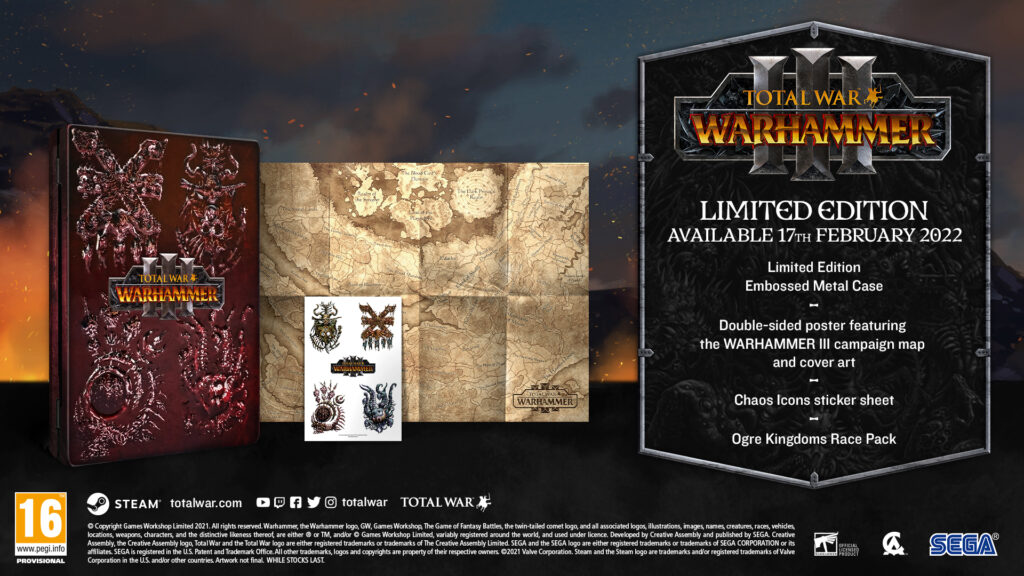
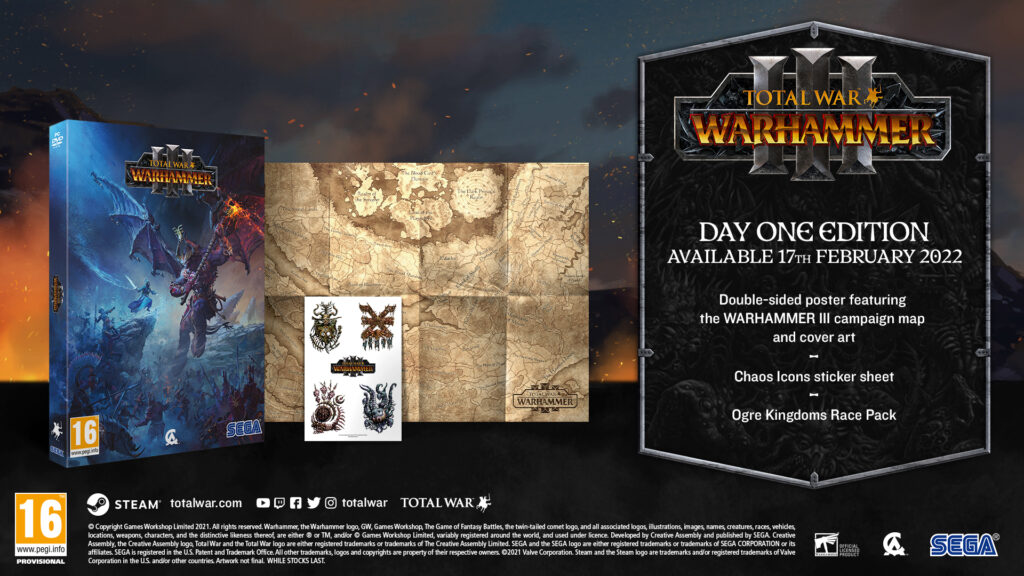
IS THERE A PHYSICAL COLLECTOR’S EDITION OF TOTAL WAR: WARHAMMER III?
Unfortunately not. A combination of the global COVID-19 pandemic and its impact on other industries, as well as our own need to work from home through the final two years of WARHAMMER III’s development has resulted in us not having a physical collector’s edition for WARHAMMER III. We can only apologise for any frustration and inconvenience this may cause.
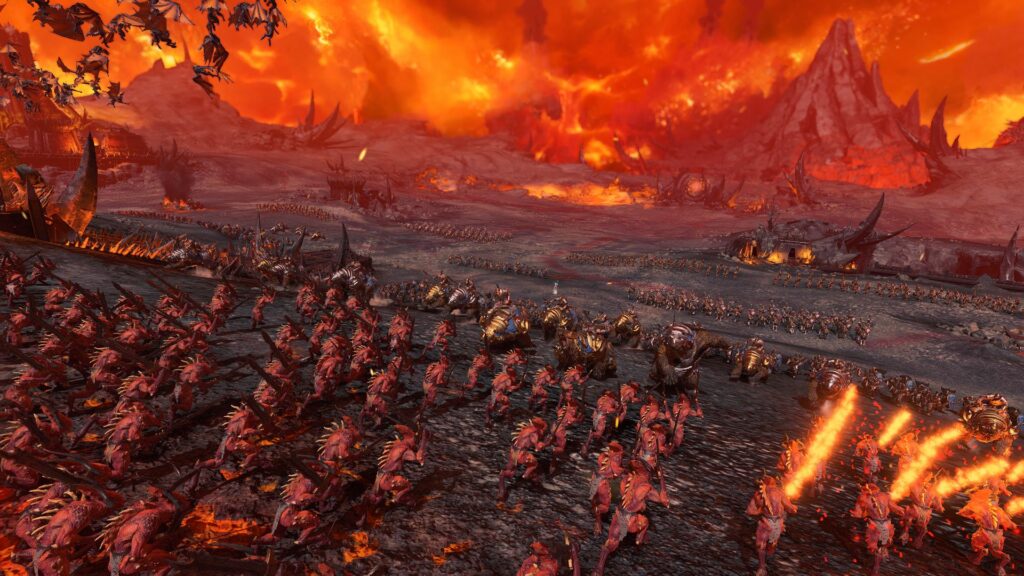
ARE THERE ANY PLANS FOR ANY TOTAL WAR: WARHAMMER III CONTENT TO BE EXCLUSIVE TO A PARTICULAR STORE?
No, all Total War: WARHAMMER III content will be released simultaneously on all storefronts.
WILL TOTAL WAR: WARHAMMER AND TOTAL WAR: WARHAMMER II BE AVAILABLE ON THE EPIC GAMES STORE AND THE WINDOWS STORE IN THE FUTURE?
Yes, we hope to add these games – and their DLC – to both store fronts in the future.
CAN I PURCHASE DLC FOR TOTAL WAR: WARHAMMER GAMES I OWN ON ONE STORE ON ANOTHER (AND VICE VERSA)?
Currently it’s not possible to track the different Total War: WARHAMMER content you own across different storefronts. So, for example, if you buy Total War: WARHAMMER on the Epic Games Store, you will also need to buy the DLC on the Epic Games Store in order to use it.
The same applies for claiming the free combined map DLC – you would need to own both Total War: WARHAMMER and Total War: WARHAMMER II on the same store in order to claim it.
WILL TOTAL WAR: WARHAMMER III BE AVAILABLE ON MACOS AND LINUX?
Yes, macOS and Linux versions will be available on Steam, developed and published by Feral Interactive.
WILL TOTAL WAR: WARHAMMER III HAVE CROSS-STORE MULTIPLAYER?
Yes, we intend to support cross-store multiplayer at launch.
EARLY ADOPTER BONUS
WHAT IS EARLY ADOPTER BONUS CONTENT?
Early Adopter bonus content for Total War: WARHAMMER III is DLC released with the game, which is free to anyone who pre-orders or purchases the game within the first week of release. Afterwards, it will be available as a standard DLC, purchasable by anyone on any store.
AND WHAT IS IT FOR WARHAMMER III?
The Ogre Kingdoms race pack is the Early Adopter bonus for Total War: WARHAMMER III. This adds a whole new faction, the Ogre Kingdoms, as playable on the campaign map, including two legendary lords. They have their own units, mechanics, goals, and stories and we can’t wait to tell you more about them – look out for more articles in the coming couple of weeks detailing everything you want to know.
TELL ME MORE ABOUT THE OGRE KINGDOMS
Above is a cool trailer, and there’s some more details over on the official website. Look out for campaign mechanics, the full roster, legendary lords, and much more as we go forward.
WILL TOTAL WAR: WARHAMMER III REVIEWS LAND BEFORE THE GAME IS RELEASED?
Yes – as with all recent Total War titles, our review embargo will drop before launch, allowing you time to decide whether to pre-order.
CONTENT
IS TOTAL WAR: WARHAMMER III GOING TO BE SET DURING THE END TIMES AND FEATURE STUFF FROM AGE OF SIGMAR?
No, as with Total War: WARHAMMER and Total War: WARHAMMER II, Total War: WARHAMMER III is set around the reign of Karl Franz. Our primary source is Warhammer Fantasy Battles 8th Edition, although we have and will continue to use older editions for inspiration where appropriate.
WHAT RACES WILL BE AVAILABLE IN TOTAL WAR: WARHAMMER III AT LAUNCH?
We are excited to be able to confirm that Total War: WARHAMMER III contains a wider selection of individual races than any previous Total War: WARHAMMER core title.
Deep within the realms of Chaos the four Ruinous Powers of Nurgle, Slaanesh, Tzeentch, and Khorne prepare for war and two mighty kingdoms stand sentinel: the stern warriors of Kislev and the vast empire of Grand Cathay.
So far we have revealed full rosters for…
We’ve also introduced various legendary lords in their own posts:
And here’s some campaign mechanics for each faction:
IS ALL THIS NEW KISLEV AND GRAND CATHAY CONTENT FOR TOTAL WAR: WARHAMMER III LEGIT?
Yes! Games Workshop has expanded and created these factions, and partnered with us. You can find out all about it from them over at Warhammer Community here including some great interviews.
WHOA, THIS ALL LOOKS GREAT – YOU MUST BE NEARLY DONE, RIGHT?
Total War: WARHAMMER III is still in development. Some of what you’re seeing is non-final. If you have feedback on anything you’re seeing, we’d be happy to read it on the forums, Discord, Twitter, Instagram, or via squig rider.
WILL THERE BE A COMBINED MAP FOR OWNERS OF ALL THREE GAMES?
Yes, though currently our focus is on Total War: WARHAMMER III.
We will release a massive combined map that will be a huge free DLC for owners of all three games, and we’ll have more detail later.
Note that you will need to own all three parts of the trilogy through a single store front in order to claim this free DLC. Please see above for details.
WILL THERE BE A BLOOD FOR THE BLOOD GOD PACK FOR TOTAL WAR: WARHAMMER III?
Yes. Much like Blood for the Blood God 2, it will be free for anyone who owns a previous version of the DLC for either WARHAMMER I or II. It will be released soon after launch.
WILL YOU BE CONTINUING TO SUPPORT TOTAL WAR: WARHAMMER II AFTER THE LAUNCH OF TOTAL WAR: WARHAMMER III?
As you might expect, our focus will shift towards supporting Total War: WARHAMMER III following its launch.
We have released the Silence & Fury DLC for Total War: WARHAMMER II this year and are continuing our efforts to patch and update the game as necessary.
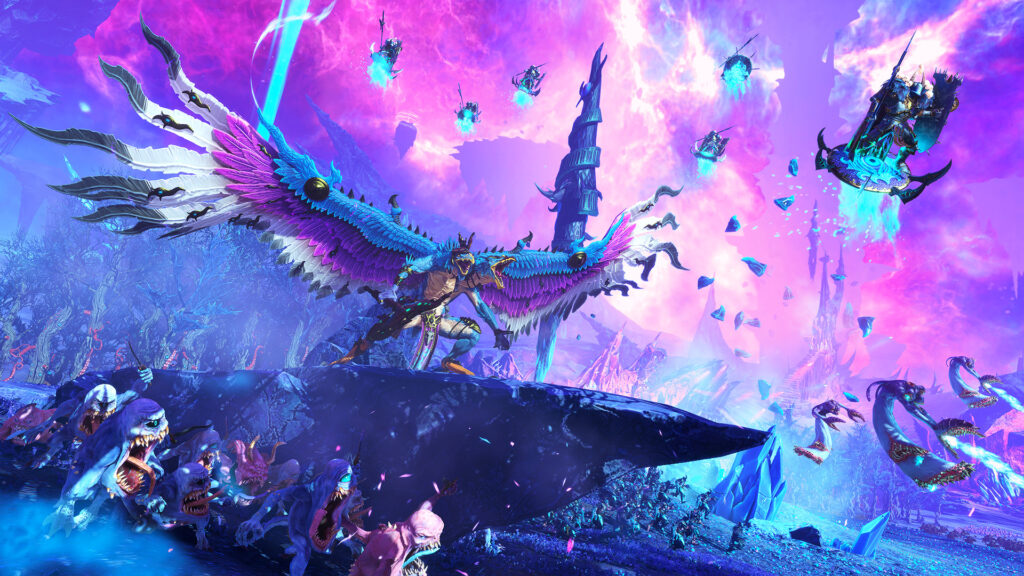
GAMEPLAY
WHAT IS A TOTAL WAR: WARHAMMER III SURVIVAL BATTLE?
As part of Warhammer III’s campaign narrative, each faction you play as must embark on a terrifying journey through the four Realms of Chaos. To achieve your aims in each realm, you’ll need to overcome the daemonic forces you encounter there in a rare and epic new battle type called a survival battle. Check out this trailer to see it in action.
To be successful here you’ll have to carve your way across the map and secure the three capture points whilst fighting off multiple waves of daemons. As you capture parts of the map you will earn battle currency called ‘supplies’ that allow you to build towers and barricades, recruit new warriors, and upgrade and replenish your units. The waves of daemons will increase in number and difficulty as you progress before the climax where you fight an exalted daemon belonging to that god.
Survival battles are playable in custom battle as well as multiplayer, so bring your friends to help you manage such an epic encounter.
WHAT ARE THE NEW GAME MODES?
Alongside Survival Battles, Total War: WARHAMMER III will also feature Domination Battles, Minor Settlement Battles, and Storm of Chaos battles. The former is a brand-new multiplayer battle mode, whilst the latter sees the return of a Total War favourite that’s brimming with new features which differentiate it from its predecessors. You can read more about the battle changes coming in WARHAMMER III in this dedicated post, more on Minor Settlement Battles and our Siege Rework here, and Storm of Chaos and updates to the magic system here.
WILL TOTAL WAR: WARHAMMER III BE LOCALISED IN MY LANGUAGE?
Total War: WARHAMMER III will only have English language audio. However, UI and text localisation will be available in English, French, Italian, German, Spanish, Russian, Polish, Czech, Turkish, Brazilian Portuguese, Korean, and simplified as well as traditional Chinese.
WILL TOTAL WAR: WARHAMMER III HAVE MULTIPLAYER SUPPORT AT LAUNCH?
Yes – we’ll have more details about this to share as we get closer to launch.
WILL TOTAL WAR: WARHAMMER III SUPPORT MODS AT LAUNCH?
Yes, and we’ll have more details about this closer to launch.
TOTAL WAR: WARHAMMER III
Ella McConnell
November 4 2021
Welcome to the FAQ for Total War: WARHAMMER III – here you can find links to a lot of our other content about the game, as well as all the vital stats of the game itself.
中文版请在我们的Bilibili专栏查看
PLATFORMS & STOREFRONTS
WHAT IS THE TOTAL WAR: WARHAMMER III RELEASE DATE?
Total War: WARHAMMER III will release on February 17, 2022. Pre-order now.

WHICH PLATFORMS WILL TOTAL WAR: WARHAMMER III BE AVAILABLE ON?
Total War: WARHAMMER III will be available on PC and will also be available as close to launch day as possible on macOS and Linux thanks to our friends at Feral Interactive – we’ll be confirming exactly when closer to release day.
WHICH STORES WILL TOTAL WAR: WARHAMMER III BE AVAILABLE THROUGH?
You can pick up your copy of Total War: WARHAMMER III on Steam, the Epic Games Store, and the Microsoft Store. You can also purchase your copy directly from Creative Assembly here – the only difference is that more of the price you pay will go directly to the studio.
In addition, Total War: WARHAMMER III will be available as part of Game Pass for PC. See below for more details.
Other digital storefronts are also available – please check SEGA’s list of approved partners here.
Physical copies of Total War: WARHAMMER III will also be available in most territories – please check with your preferred local game stockist.
IS THE GAME PASS FOR PC VERSION ANY DIFFERENT?
No, it is the full version of the game. If you own WARHAMMER III through Game Pass for PC, you will also be able to purchase future DLC for it through the Microsoft Store, as well as access Free-LC as it becomes available. For more information on Game Pass for PC, click here.
ARE THERE SPECIAL EDITIONS OF TOTAL WAR: WARHAMMER III?
We have two physical special editions for WARHAMMER III. The Day One Edition, available February 17, comes with a double-sided poster of the WARHAMMER III campaign map and a set of Chaos Icon stickers. The Limited Edition, available on the same day, as comes with an Embossed Metal Case. See them both below.


IS THERE A PHYSICAL COLLECTOR’S EDITION OF TOTAL WAR: WARHAMMER III?
Unfortunately not. A combination of the global COVID-19 pandemic and its impact on other industries, as well as our own need to work from home through the final two years of WARHAMMER III’s development has resulted in us not having a physical collector’s edition for WARHAMMER III. We can only apologise for any frustration and inconvenience this may cause.

ARE THERE ANY PLANS FOR ANY TOTAL WAR: WARHAMMER III CONTENT TO BE EXCLUSIVE TO A PARTICULAR STORE?
No, all Total War: WARHAMMER III content will be released simultaneously on all storefronts.
WILL TOTAL WAR: WARHAMMER AND TOTAL WAR: WARHAMMER II BE AVAILABLE ON THE EPIC GAMES STORE AND THE WINDOWS STORE IN THE FUTURE?
Yes, we hope to add these games – and their DLC – to both store fronts in the future.
CAN I PURCHASE DLC FOR TOTAL WAR: WARHAMMER GAMES I OWN ON ONE STORE ON ANOTHER (AND VICE VERSA)?
Currently it’s not possible to track the different Total War: WARHAMMER content you own across different storefronts. So, for example, if you buy Total War: WARHAMMER on the Epic Games Store, you will also need to buy the DLC on the Epic Games Store in order to use it.
The same applies for claiming the free combined map DLC – you would need to own both Total War: WARHAMMER and Total War: WARHAMMER II on the same store in order to claim it.
WILL TOTAL WAR: WARHAMMER III BE AVAILABLE ON MACOS AND LINUX?
Yes, macOS and Linux versions will be available on Steam, developed and published by Feral Interactive.
WILL TOTAL WAR: WARHAMMER III HAVE CROSS-STORE MULTIPLAYER?
Yes, we intend to support cross-store multiplayer at launch.
EARLY ADOPTER BONUS
WHAT IS EARLY ADOPTER BONUS CONTENT?
Early Adopter bonus content for Total War: WARHAMMER III is DLC released with the game, which is free to anyone who pre-orders or purchases the game within the first week of release. Afterwards, it will be available as a standard DLC, purchasable by anyone on any store.
AND WHAT IS IT FOR WARHAMMER III?
The Ogre Kingdoms race pack is the Early Adopter bonus for Total War: WARHAMMER III. This adds a whole new faction, the Ogre Kingdoms, as playable on the campaign map, including two legendary lords. They have their own units, mechanics, goals, and stories and we can’t wait to tell you more about them – look out for more articles in the coming couple of weeks detailing everything you want to know.
TELL ME MORE ABOUT THE OGRE KINGDOMS
Above is a cool trailer, and there’s some more details over on the official website. Look out for campaign mechanics, the full roster, legendary lords, and much more as we go forward.
WILL TOTAL WAR: WARHAMMER III REVIEWS LAND BEFORE THE GAME IS RELEASED?
Yes – as with all recent Total War titles, our review embargo will drop before launch, allowing you time to decide whether to pre-order.
CONTENT
IS TOTAL WAR: WARHAMMER III GOING TO BE SET DURING THE END TIMES AND FEATURE STUFF FROM AGE OF SIGMAR?
No, as with Total War: WARHAMMER and Total War: WARHAMMER II, Total War: WARHAMMER III is set around the reign of Karl Franz. Our primary source is Warhammer Fantasy Battles 8th Edition, although we have and will continue to use older editions for inspiration where appropriate.
WHAT RACES WILL BE AVAILABLE IN TOTAL WAR: WARHAMMER III AT LAUNCH?
We are excited to be able to confirm that Total War: WARHAMMER III contains a wider selection of individual races than any previous Total War: WARHAMMER core title.
Deep within the realms of Chaos the four Ruinous Powers of Nurgle, Slaanesh, Tzeentch, and Khorne prepare for war and two mighty kingdoms stand sentinel: the stern warriors of Kislev and the vast empire of Grand Cathay.
So far we have revealed full rosters for…
We’ve also introduced various legendary lords in their own posts:
And here’s some campaign mechanics for each faction:
IS ALL THIS NEW KISLEV AND GRAND CATHAY CONTENT FOR TOTAL WAR: WARHAMMER III LEGIT?
Yes! Games Workshop has expanded and created these factions, and partnered with us. You can find out all about it from them over at Warhammer Community here including some great interviews.
WHOA, THIS ALL LOOKS GREAT – YOU MUST BE NEARLY DONE, RIGHT?
Total War: WARHAMMER III is still in development. Some of what you’re seeing is non-final. If you have feedback on anything you’re seeing, we’d be happy to read it on the forums, Discord, Twitter, Instagram, or via squig rider.
WILL THERE BE A COMBINED MAP FOR OWNERS OF ALL THREE GAMES?
Yes, though currently our focus is on Total War: WARHAMMER III.
We will release a massive combined map that will be a huge free DLC for owners of all three games, and we’ll have more detail later.
Note that you will need to own all three parts of the trilogy through a single store front in order to claim this free DLC. Please see above for details.
WILL THERE BE A BLOOD FOR THE BLOOD GOD PACK FOR TOTAL WAR: WARHAMMER III?
Yes. Much like Blood for the Blood God 2, it will be free for anyone who owns a previous version of the DLC for either WARHAMMER I or II. It will be released soon after launch.
WILL YOU BE CONTINUING TO SUPPORT TOTAL WAR: WARHAMMER II AFTER THE LAUNCH OF TOTAL WAR: WARHAMMER III?
As you might expect, our focus will shift towards supporting Total War: WARHAMMER III following its launch.
We have released the Silence & Fury DLC for Total War: WARHAMMER II this year and are continuing our efforts to patch and update the game as necessary.

GAMEPLAY
WHAT IS A TOTAL WAR: WARHAMMER III SURVIVAL BATTLE?
As part of Warhammer III’s campaign narrative, each faction you play as must embark on a terrifying journey through the four Realms of Chaos. To achieve your aims in each realm, you’ll need to overcome the daemonic forces you encounter there in a rare and epic new battle type called a survival battle. Check out this trailer to see it in action.
To be successful here you’ll have to carve your way across the map and secure the three capture points whilst fighting off multiple waves of daemons. As you capture parts of the map you will earn battle currency called ‘supplies’ that allow you to build towers and barricades, recruit new warriors, and upgrade and replenish your units. The waves of daemons will increase in number and difficulty as you progress before the climax where you fight an exalted daemon belonging to that god.
Survival battles are playable in custom battle as well as multiplayer, so bring your friends to help you manage such an epic encounter.
WHAT ARE THE NEW GAME MODES?
Alongside Survival Battles, Total War: WARHAMMER III will also feature Domination Battles, Minor Settlement Battles, and Storm of Chaos battles. The former is a brand-new multiplayer battle mode, whilst the latter sees the return of a Total War favourite that’s brimming with new features which differentiate it from its predecessors. You can read more about the battle changes coming in WARHAMMER III in this dedicated post, more on Minor Settlement Battles and our Siege Rework here, and Storm of Chaos and updates to the magic system here.
WILL TOTAL WAR: WARHAMMER III BE LOCALISED IN MY LANGUAGE?
Total War: WARHAMMER III will only have English language audio. However, UI and text localisation will be available in English, French, Italian, German, Spanish, Russian, Polish, Czech, Turkish, Brazilian Portuguese, Korean, and simplified as well as traditional Chinese.
WILL TOTAL WAR: WARHAMMER III HAVE MULTIPLAYER SUPPORT AT LAUNCH?
Yes – we’ll have more details about this to share as we get closer to launch.
WILL TOTAL WAR: WARHAMMER III SUPPORT MODS AT LAUNCH?
Yes, and we’ll have more details about this closer to launch.
Low res WH3 main campaign map image

Seems like the map is wrapped around the north pole and the Chaos Realms will be physical places on the map.
Space Satan
Arcane

Trailer with units leaked
https://www.redditmedia.com/user/To...ref_source=embed&ref=share&embed=true
https://www.redditmedia.com/user/To...ref_source=embed&ref=share&embed=true
Space Satan
Arcane

FFS ogres will have 23 units.
tabacila
Augur
- Joined
- Nov 2, 2011
- Messages
- 326
Cathay was never on my wish list and Kislev looks too WoWish and flanderized for my tastes. My only hopes are for Ogres and the Chaos Dwarfs.
The Microsoft store page has a list of characters:

The lack of Bruisers, the melee heroes of the OK, and the fact that there are two more named characters, a lord and a hero hints at possibly 1+ DLCs.
Some of those 23 units are variants with dual weapons/great weapons/etc. When we'll see the full roster we'll see exactly which units they also left out for future DLC. My money is on Thundertusks (since CA love them some big centerpiece monsters) and Yhetees at least.
Hopefully the OK won't suffer the fate of all other TW WH pre-order DLCs and get forgotten for entire years.
Lol at Greasus being mounter on a mobility scooter instead using his gnoblar bearers.
The Microsoft store page has a list of characters:

The lack of Bruisers, the melee heroes of the OK, and the fact that there are two more named characters, a lord and a hero hints at possibly 1+ DLCs.
Some of those 23 units are variants with dual weapons/great weapons/etc. When we'll see the full roster we'll see exactly which units they also left out for future DLC. My money is on Thundertusks (since CA love them some big centerpiece monsters) and Yhetees at least.
Hopefully the OK won't suffer the fate of all other TW WH pre-order DLCs and get forgotten for entire years.
Lol at Greasus being mounter on a mobility scooter instead using his gnoblar bearers.

- Joined
- Jun 28, 2017
- Messages
- 33,584
No Chaos Dwarves? Fuck that.
e: Ogre grilling a bat, lmao
Trailer is shit. They clearly tried to copy the shanty from the VC trailer but it sounds bad. Shoulda gone with THROAT SINGING since Ogres are supposed to be Mongoloids anyway.
e: Ogre grilling a bat, lmao
Trailer is shit. They clearly tried to copy the shanty from the VC trailer but it sounds bad. Shoulda gone with THROAT SINGING since Ogres are supposed to be Mongoloids anyway.
Last edited:
SpaceWizardz
Liturgist
- Joined
- Sep 28, 2018
- Messages
- 1,176
With Ogres as pre-order Chorfs are a given for DLC1.
No Ind/Nippon isn't surprising, I guess that leaves DLC2 for Hobgoblins?
Obvious spots for Toddbringer and more Norsca, and Lokhir will probably get a start on the bottom right isles.
*Also, damn, February is busy.
No Ind/Nippon isn't surprising, I guess that leaves DLC2 for Hobgoblins?
Obvious spots for Toddbringer and more Norsca, and Lokhir will probably get a start on the bottom right isles.
*Also, damn, February is busy.
Last edited:
Space Satan
Arcane

A lot of units means CA won't touch it later - like with Tomb Kings - they had huge roster at the start and never got updated. But due to ЕЛ being their best DLC and well implemented race people ignored that.
Space Satan
Arcane

Let's remember that this is canon


You probably meant this:Let's remember that this is canon


Delterius
Arcane
Doubtful it's the name but to be quite honest if I were in charge of Warhammer and wanted to implement 'Araby' I'd like to change a lot of things about it's lore. It's a middle east pastiche much in the same way Bretonnia is an Anglois pastiche, but unlike Bretonnia it's not very inspired. Too little 1001 nights, too much post turkic middle east. Not enough inspiration from actual historical arab or turkic armies, too much inspiration from late 1800s caricatures of what those cultures were like. Hell, I think some of the arabyan units use the fez, which is just hilarious. In a way the Araby lore reminds me of certain subpar versions of Bretonnian lore and CA is wise to treat all editions, with their ups and downs, as a source of inspiration, rather than marrying any one edition's idiosyncracies and calling it a day.Are they avoiding Araby because of the name? They had a army roster in Warmaster.
And the thing about that approach is that it means things like Cathay, Ind and Araby need a whole lot of effort put into their fluff. Cathay was worth that effort. Kislev was worth that effort and plus, it benefitted from Games Workshop already wanting to revitalize the old world. Araby doesn't have that. Nor does it feature prominently in the map of Warhammer 3.
I would really like to use magic carpets in the games though.
tabacila
Augur
- Joined
- Nov 2, 2011
- Messages
- 326
Ogre mechanics:
The Ogre Camp idea is pretty nice and probably will be used to implement the Dogs of War down the line.[/SPOILER]
CONSUME THE WORLD WITH THE OGRE KINGDOMS CAMPAIGN MECHANICS
TOTAL WAR: WARHAMMER III
Ben Barrett
November 5 2021
The world’s biggest eaters, rowdiest Blood Bowl fans, and largest overall nuisances have arrived in Total War: WARHAMMER III. After many months of speculation, your Early Adopter bonus for the game is the Ogre Kingdoms, filling out the central area of the map with the many tribes of maneaters, ironguts, bulls, and many more. They’re a fully-fledged faction (and will be present as potential enemies and allies on the campaign map even if you don’t own their DLC from getting the game early enough or buying it separately) with their own legendary lords, units, heroes, goals, dreams, hopes, meals – and campaign mechanics, which brings us to the below.
中文版请在我们的Bilibili专栏查看
Greasus Goldtooth and Skrag the Slaughterer have quite different campaigns, and we’ll get into the specifics of them a little further down the road in our Legendary Lord mechanics series. However, what’s laid out below is what they share, the fundamentals of the Ogre race and how they interact, make war, and, most importantly, eat.
CAMPS
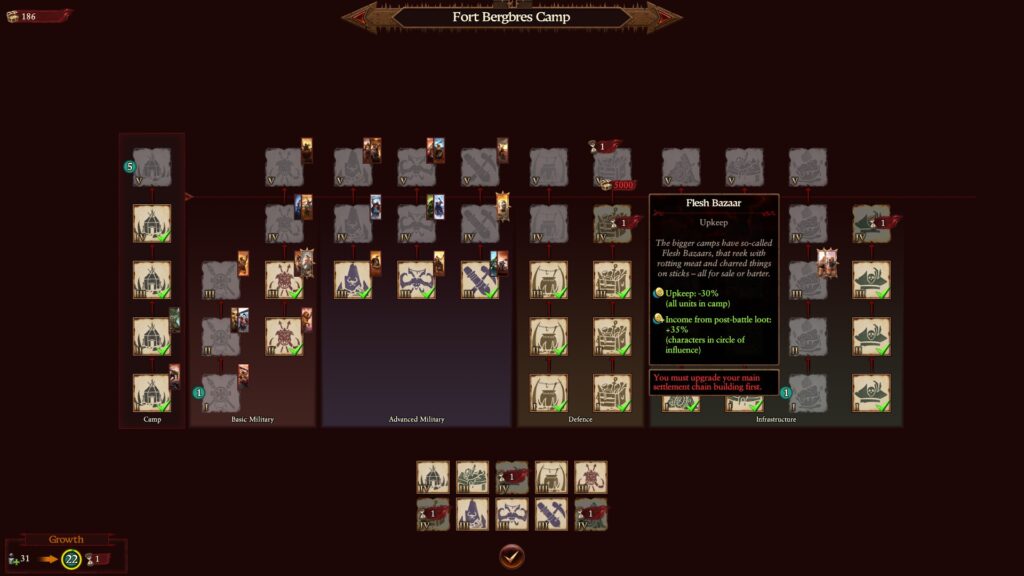
Perhaps the most iconic area of Ogre society is the camp – a great set of buildings (or, often, assorted piles) around a central pot of meat, gristle, beer, and whatever else has been thrown in on this occasion. Ogre Camps can be set up at any sufficient distance from existing settlements and act as major settlements for the faction. Any captured or colonised settlements are minors with four building slots and max rank three.
Camps are limited in number by technology and, as you’ll see below, unlocking your first camp is the initial tech for the race. New buildings require population surplus to create, similar to a horde, and if the garrison is defeated the camp is destroyed.
However, as well as providing access to higher tier units and buildings, there are some massive benefits to camps. They can be deployed in any territory and any distance from your other lands, so long as you can get an army there. Assuming it’s in enemy territory, the garrison inside will automatically be raiding the province it’s in every turn, generating additional income. This garrison can be reinforced by trading units to and from it with an army or recruiting directly into the camp, meaning you can have a properly massive and powerful raiding army that is also well-defended within a pseudo-settlement that must be sieged to be destroyed. It can also provide units to passing armies, giving you a refueling and upgrading station for your forces when they don’t have time to recruit themselves.
Camps also exert a sphere of influence of decent size on the campaign map, and any armies within that area will receive various bonuses, as well as being able to use local recruitment. Various buildings inside the camp will also have effects within this area of influence, letting it provide additional replenishment, extra Meat (see below), or other benefits. Naturally, this makes placement vital to consider – a more defensible location on the edge of your own territory is valuable, but one in the center of enemy provinces is quite a different prospect. The more fighting within range of a camp, the better.
For other factions, Ogre Camps represent a place to bring Ogre talents aboard. Any army that is near an Ogre Camp and is not at war with the owner can hire Ogre Bulls as mercenaries.
Of note is that the non-recruitment buildings in camps also provide some pretty hefty upgrades. Loot Piles give an obnoxious amount of gold per turn while there are options for massively reduced upkeep of the units inside. There are also possibilities for huge increases in local recruitment capacities, global effects, and other profitable ventures. Owning regions is valuable, but multiple large camps will render you a force to be reckoned with.
CONTRACTS
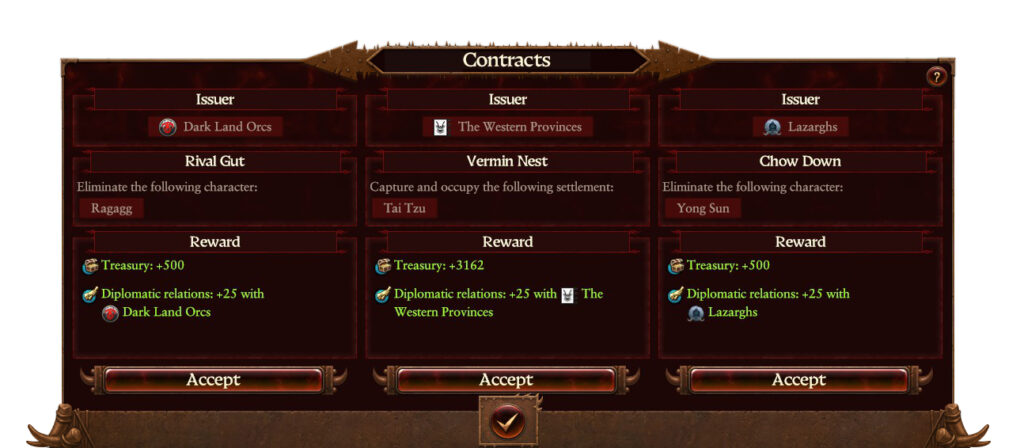
There’s a reason Ogres first entered Total War as mercenaries – it’s what they do best. They’re the largest, toughest, most violent force they’ve ever met (Greenskins really have a problem with this), so why not use their natural talents for profit? Hence, contracts, special missions given to you as an Ogre player by the various AI factions around you.
Every ten turns you will be presented with three potential contracts, each for attacking cities, killing characters, or destroying armies. These will come from factions you are not at war with and offer money for completion. You will also get a significant relationship boost with the hiring faction should you complete their contract.
This is a good excuse to start a war, usually one which will get you a good reputation with someone else nearby. Of course, money talks much louder than loyalty, and there’s nothing stopping you turning on just about everyone once you’ve taken the gold they were willing to give up without a fight.
MEAT
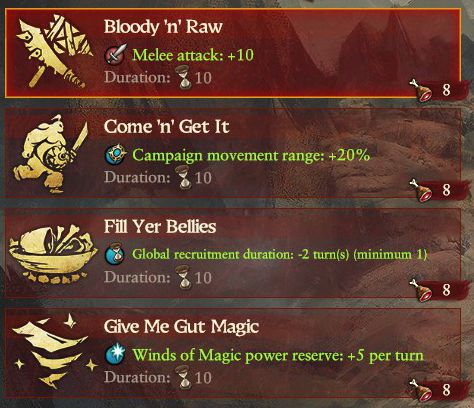
As your body may run on water and nutrients and our economy on the blood of the workers, Ogre society runs on meat. Eating and fighting are the central tenets of everything they do, and usually the fighting is to get ready for a big batch of eating, and the eating is so they’re well-fueled for the fighting. The two are often combined in horrific displays of brutality on the battlefield that will send enemies fleeing.
Thus, every Ogre army has a separate upkeep, as well as in gold, of Meat. One unit, one meat consumed. The meat each army has and if it’s increasing or decreasing is tracked above its banner on the campaign map, in the same spot as any passive effects and if it’s garrisoned or not. This upkeep is waived when within range of a friendly Ogre Camp, and as mentioned, there are plenty of camp buildings with interactions surrounding meat. Naturally, enemy armies can also be, ahem, processed into meat, post-defeat.
Far from just a second upkeep bar, meat also has a number of uses. Any time an Ogre army is engaged in battle, it can initiate a pre-battle feast. Up to five meat can be used from its stores, with each piece giving a stacking bonus to speed, charge bonus, and unit mass. Bigger, heavier ogres do bigger, more powerful charges.
In addition, all Ogre armies can initiate Offerings to the Great Maw, giving some of their meat up for bonuses. These are buffs that last for a large number of turns for that army, and are:
Only one of these buffs can be active at a time, but they can have permanent uptime assuming there is always spare meat lying around when the offering is available.
BIG NAMES
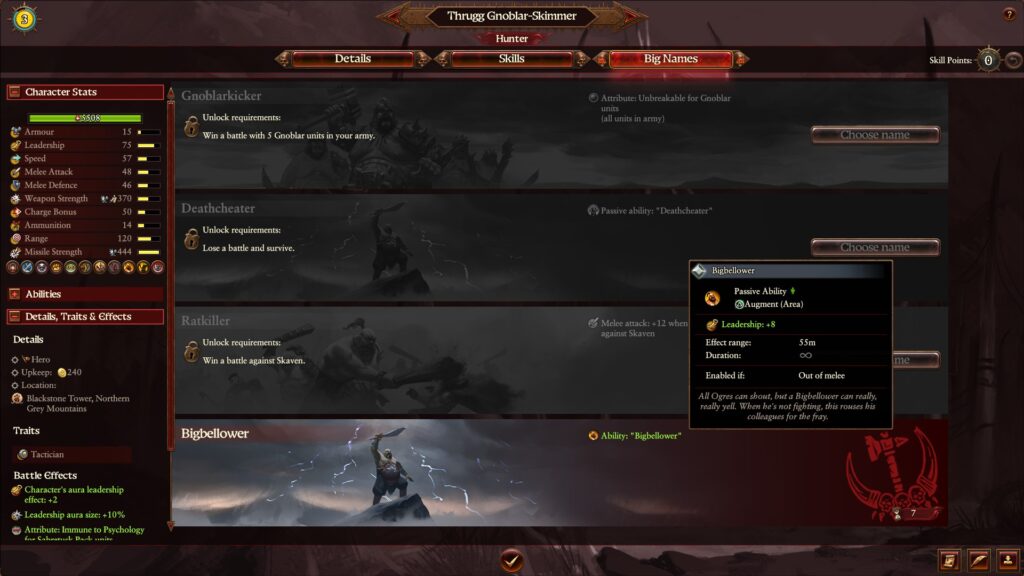
Ogres can’t read or write and have no interest in the matter. Their campfire stories, once the fighting has died down and only the most obese are still eating, come from personally-told tales, handed from generation to generation or bragged about from the purpertrator. Thus, the concept of Ogre titles, or Big Names, was born. While Settra may claim the most length, Ogres have the largest breadth of names and their possible meanings.
Each and every Ogre Lord has four Big Names he can strive for, each with different unlock conditions. This is as true of our Legendary Lords, Greasus Goldtooth and Skrag the Slaughterer, as it is for the Tyrants and Slaughtermasters that lead your other armies. For the legendary, there is a bespoke choice of four, while the others take a random selection from a wider pool for each Lord type.
Once a Big Name is unlocked, it can be equipped as a primary title, giving a specific effect. The system as a whole is similar to the passive traits that Lords advertise when they are hired, but customisable depending on your plans and usually more powerful. Changing primary titles can be done on a short cooldown, so mix and match as needed.
Here’s four from a random Tyrant, Thrugg Brutbane, I just generated:
As you can see, they aren’t army-defining, but could be used to make a specific lord more his own, as well as giving mini-objectives from turn to turn with each of your armies. The Legendary Lord versions are a step above these in power, supplementing the power of your faction.
TECH TREE
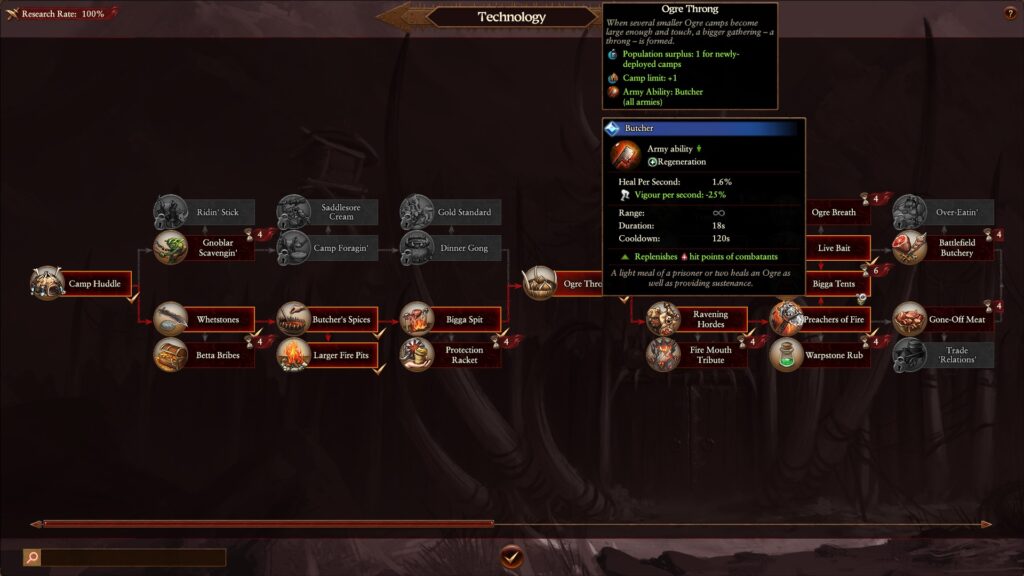
As mentioned, the subtleties of language and thus research, knowledge retention, education and much else that the rest of the world uses to advance society, are mysterious and uninteresting to Ogres.
Instead, their idea of research is mostly theft, coming up with better ways to eat more and charge higher sums for their services, and consuming the brains of their enemies to discover new possibilities. Their tech tree reflects this by being focused on key points that increase the number of camps you have access to, as well as the starting population of those camps, letting you set up new buildings quicker.
It is quite a dense tree (echoing its researchers), taking not a lot of time to go from end to end if you simply focus on progressing, but with lots and lots of possibilities to take a tech here or there that significantly buffs a unit or economic element. Several of the camp-improving techs also unlock powerful army abilities focused on consuming prisoners in battle for fantastic and terrifying effects.
FILL YER BELLY
Those are the Ogres – violent, gluttonous, and a hell of a lot of fun to play. While they are not as automatically warlike as the daemon races (who they are as happy to work and ally with, so long as it pays), the haphazard nature with which they engage in warfare and their easy-going nature comes to the fore easily. Oh, well, if someone’s going to pay – why not take this city or that? Why not crush an army or kill a general? It’s all meat for the belly, after all.
TOTAL WAR: WARHAMMER III
Ben Barrett
November 5 2021
The world’s biggest eaters, rowdiest Blood Bowl fans, and largest overall nuisances have arrived in Total War: WARHAMMER III. After many months of speculation, your Early Adopter bonus for the game is the Ogre Kingdoms, filling out the central area of the map with the many tribes of maneaters, ironguts, bulls, and many more. They’re a fully-fledged faction (and will be present as potential enemies and allies on the campaign map even if you don’t own their DLC from getting the game early enough or buying it separately) with their own legendary lords, units, heroes, goals, dreams, hopes, meals – and campaign mechanics, which brings us to the below.
中文版请在我们的Bilibili专栏查看
Greasus Goldtooth and Skrag the Slaughterer have quite different campaigns, and we’ll get into the specifics of them a little further down the road in our Legendary Lord mechanics series. However, what’s laid out below is what they share, the fundamentals of the Ogre race and how they interact, make war, and, most importantly, eat.
CAMPS

Perhaps the most iconic area of Ogre society is the camp – a great set of buildings (or, often, assorted piles) around a central pot of meat, gristle, beer, and whatever else has been thrown in on this occasion. Ogre Camps can be set up at any sufficient distance from existing settlements and act as major settlements for the faction. Any captured or colonised settlements are minors with four building slots and max rank three.
Camps are limited in number by technology and, as you’ll see below, unlocking your first camp is the initial tech for the race. New buildings require population surplus to create, similar to a horde, and if the garrison is defeated the camp is destroyed.
However, as well as providing access to higher tier units and buildings, there are some massive benefits to camps. They can be deployed in any territory and any distance from your other lands, so long as you can get an army there. Assuming it’s in enemy territory, the garrison inside will automatically be raiding the province it’s in every turn, generating additional income. This garrison can be reinforced by trading units to and from it with an army or recruiting directly into the camp, meaning you can have a properly massive and powerful raiding army that is also well-defended within a pseudo-settlement that must be sieged to be destroyed. It can also provide units to passing armies, giving you a refueling and upgrading station for your forces when they don’t have time to recruit themselves.
Camps also exert a sphere of influence of decent size on the campaign map, and any armies within that area will receive various bonuses, as well as being able to use local recruitment. Various buildings inside the camp will also have effects within this area of influence, letting it provide additional replenishment, extra Meat (see below), or other benefits. Naturally, this makes placement vital to consider – a more defensible location on the edge of your own territory is valuable, but one in the center of enemy provinces is quite a different prospect. The more fighting within range of a camp, the better.
For other factions, Ogre Camps represent a place to bring Ogre talents aboard. Any army that is near an Ogre Camp and is not at war with the owner can hire Ogre Bulls as mercenaries.
Of note is that the non-recruitment buildings in camps also provide some pretty hefty upgrades. Loot Piles give an obnoxious amount of gold per turn while there are options for massively reduced upkeep of the units inside. There are also possibilities for huge increases in local recruitment capacities, global effects, and other profitable ventures. Owning regions is valuable, but multiple large camps will render you a force to be reckoned with.
CONTRACTS

There’s a reason Ogres first entered Total War as mercenaries – it’s what they do best. They’re the largest, toughest, most violent force they’ve ever met (Greenskins really have a problem with this), so why not use their natural talents for profit? Hence, contracts, special missions given to you as an Ogre player by the various AI factions around you.
Every ten turns you will be presented with three potential contracts, each for attacking cities, killing characters, or destroying armies. These will come from factions you are not at war with and offer money for completion. You will also get a significant relationship boost with the hiring faction should you complete their contract.
This is a good excuse to start a war, usually one which will get you a good reputation with someone else nearby. Of course, money talks much louder than loyalty, and there’s nothing stopping you turning on just about everyone once you’ve taken the gold they were willing to give up without a fight.
MEAT

As your body may run on water and nutrients and our economy on the blood of the workers, Ogre society runs on meat. Eating and fighting are the central tenets of everything they do, and usually the fighting is to get ready for a big batch of eating, and the eating is so they’re well-fueled for the fighting. The two are often combined in horrific displays of brutality on the battlefield that will send enemies fleeing.
Thus, every Ogre army has a separate upkeep, as well as in gold, of Meat. One unit, one meat consumed. The meat each army has and if it’s increasing or decreasing is tracked above its banner on the campaign map, in the same spot as any passive effects and if it’s garrisoned or not. This upkeep is waived when within range of a friendly Ogre Camp, and as mentioned, there are plenty of camp buildings with interactions surrounding meat. Naturally, enemy armies can also be, ahem, processed into meat, post-defeat.
Far from just a second upkeep bar, meat also has a number of uses. Any time an Ogre army is engaged in battle, it can initiate a pre-battle feast. Up to five meat can be used from its stores, with each piece giving a stacking bonus to speed, charge bonus, and unit mass. Bigger, heavier ogres do bigger, more powerful charges.
In addition, all Ogre armies can initiate Offerings to the Great Maw, giving some of their meat up for bonuses. These are buffs that last for a large number of turns for that army, and are:
- Bloody ‘n’ Raw – extra melee attack for all units.
- Come ‘n’ Get It – additional campaign movement range for the army.
- Fill Yer Bellies – Decrease in global recruitment times.
- Give Me Gut Magic – additional Winds of Magic power reserves per turn.
Only one of these buffs can be active at a time, but they can have permanent uptime assuming there is always spare meat lying around when the offering is available.
BIG NAMES

Ogres can’t read or write and have no interest in the matter. Their campfire stories, once the fighting has died down and only the most obese are still eating, come from personally-told tales, handed from generation to generation or bragged about from the purpertrator. Thus, the concept of Ogre titles, or Big Names, was born. While Settra may claim the most length, Ogres have the largest breadth of names and their possible meanings.
Each and every Ogre Lord has four Big Names he can strive for, each with different unlock conditions. This is as true of our Legendary Lords, Greasus Goldtooth and Skrag the Slaughterer, as it is for the Tyrants and Slaughtermasters that lead your other armies. For the legendary, there is a bespoke choice of four, while the others take a random selection from a wider pool for each Lord type.
Once a Big Name is unlocked, it can be equipped as a primary title, giving a specific effect. The system as a whole is similar to the passive traits that Lords advertise when they are hired, but customisable depending on your plans and usually more powerful. Changing primary titles can be done on a short cooldown, so mix and match as needed.
Here’s four from a random Tyrant, Thrugg Brutbane, I just generated:
- Arsebelcher
- Unlocked by: It is a mystery!
- Grants: Arsebelcher ability, a leadership debuff for all enemies nearby.
- Campmaker
- Unlocked by: deploying a camp with this character.
- Grants: +1 control to local province.
- Boommaker
- Unlocked by: winning a battle with a unit of Leadbelchers in the army.
- Grants: +20% missile strength for various ranged units.
- Kineater
- Unlocked by: losing a battle but killing more enemies than your opponent.
- Grants: Passive ability Kineater, which gives unbreakable to this lord so long as they have over half HP.
As you can see, they aren’t army-defining, but could be used to make a specific lord more his own, as well as giving mini-objectives from turn to turn with each of your armies. The Legendary Lord versions are a step above these in power, supplementing the power of your faction.
TECH TREE

As mentioned, the subtleties of language and thus research, knowledge retention, education and much else that the rest of the world uses to advance society, are mysterious and uninteresting to Ogres.
Instead, their idea of research is mostly theft, coming up with better ways to eat more and charge higher sums for their services, and consuming the brains of their enemies to discover new possibilities. Their tech tree reflects this by being focused on key points that increase the number of camps you have access to, as well as the starting population of those camps, letting you set up new buildings quicker.
It is quite a dense tree (echoing its researchers), taking not a lot of time to go from end to end if you simply focus on progressing, but with lots and lots of possibilities to take a tech here or there that significantly buffs a unit or economic element. Several of the camp-improving techs also unlock powerful army abilities focused on consuming prisoners in battle for fantastic and terrifying effects.
FILL YER BELLY
Those are the Ogres – violent, gluttonous, and a hell of a lot of fun to play. While they are not as automatically warlike as the daemon races (who they are as happy to work and ally with, so long as it pays), the haphazard nature with which they engage in warfare and their easy-going nature comes to the fore easily. Oh, well, if someone’s going to pay – why not take this city or that? Why not crush an army or kill a general? It’s all meat for the belly, after all.
The Ogre Camp idea is pretty nice and probably will be used to implement the Dogs of War down the line.[/SPOILER]
fixedLet's remember that this is canon

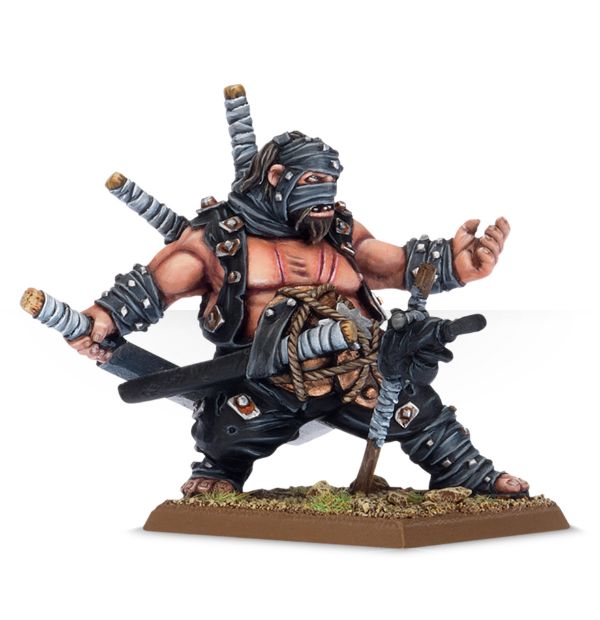
For picture links from this domain (static.wikia.nocookie.net) you usually have to remove everything after the file extension (here .jpg) for the link to work
For Araby I think CA said in the past that they didn't plan to implement it; I guess it'd be too much of a hot button issue for how much it would sell
CthuluIsSpy
Arcane
Well they have to cater to their American audience somehow.Didn't know Mississippi had an army in warhammer

Though seriously, seeing Ogres is predictable (there were a main army) but still pretty neat.
They should really add Chaos Dwarfs though, that's an army that fantasy players have been wanting to see for a while.
Not sure how they would differ from Dwarfs though. Maybe more war machines, as the Chaos Dwarfs aren't as anal-retentive over innovation?








![Glory to Codexia! [2012] Codex 2012](/forums/smiles/campaign_tags/campaign_slushfund2012.png)





















